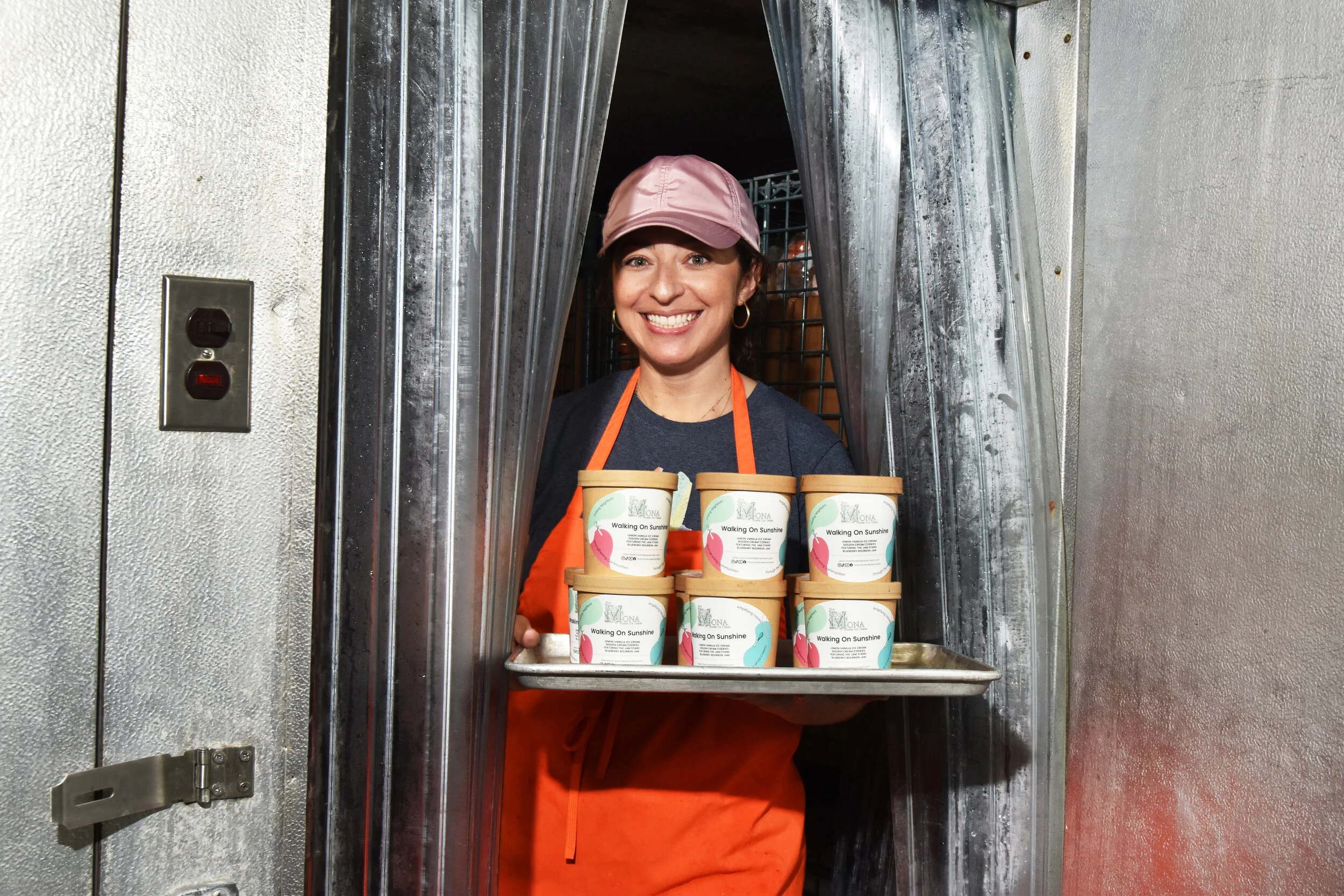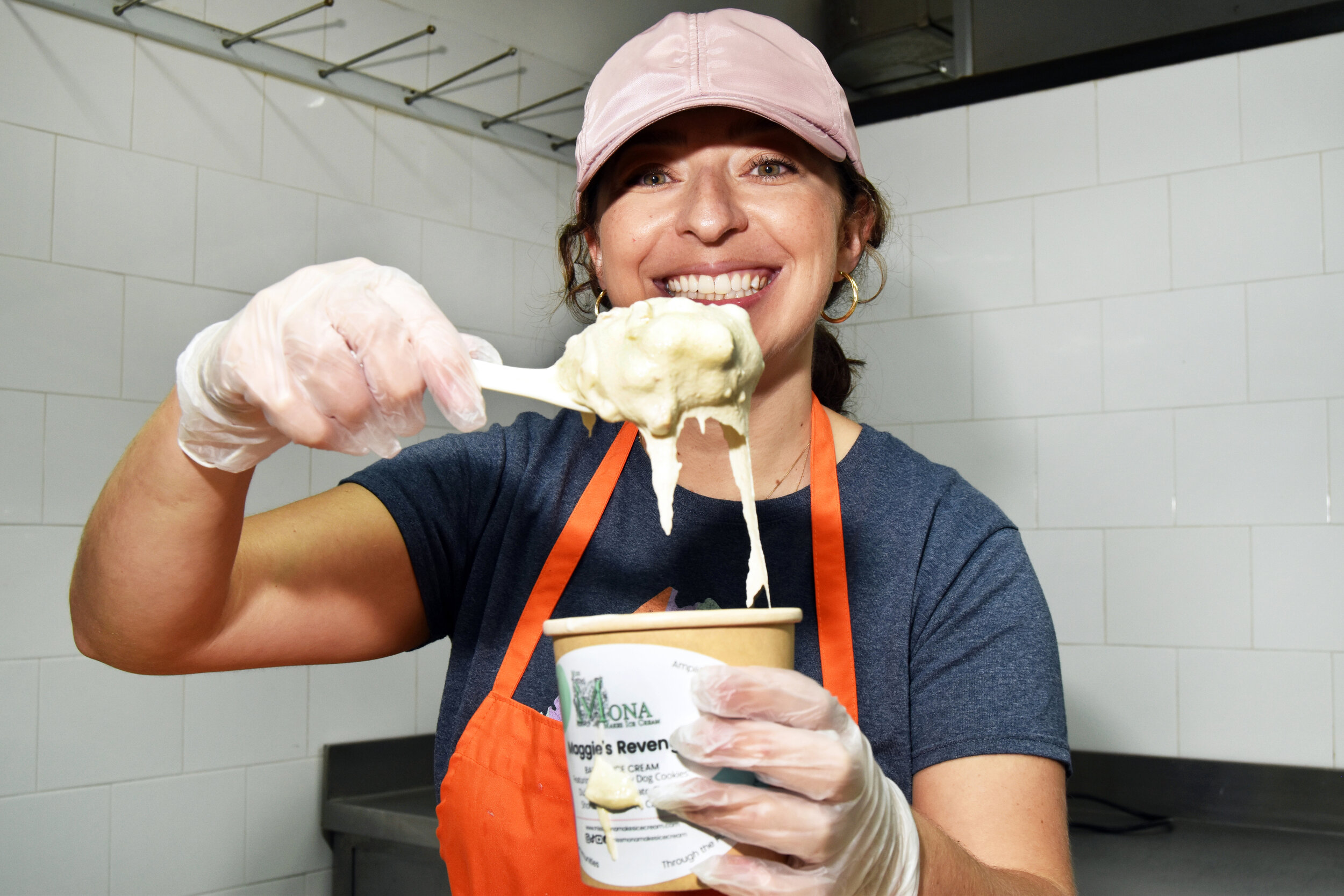The Secret To Miss Mona’s Growing Ice Cream Brand: The Way She Boosts Other Entrepreneurs
Skills of management, marketing and strategy transfer over from a previous career in nonprofits. Still, Mona Lipson wonders: Am I crazy to start a company at near 40?
Mona Lispon of Miss Mona Makes Ice Cream with her frozen creations at Cook Collective in Brooklyn. Photo: Nina Roberts
Published on The Times of Entrepreneurship on July 16, 2021
Some people look forward to summertime’s Community Supported Agriculture boxes of kale, cukes and beets. A growing number of Brooklynites are on the watch for something different: Community Supported Treats. That’s what entrepreneur Mona Lipson is calling her new small batch ice cream venture Miss Mona Makes Ice Cream, which delivers three pints of artisanal ice cream each month to Brooklyn and Manhattan residents.
“It’s not just ice cream,” Lipson explains of Miss Mona’s social impact mission, “it really is about promoting and supporting local community.” Lipson, a native Brooklynite, not only uses chunks of cookies and pastries, or swirls of jam, made by local food vendors in her ice creams, but she also actively promotes them through social media and in-person events as the city opens up.
For instance, Bahati Kidagi, originally from Tanzania, recently launched Bahati Chai selling chai sourced from East African countries. Lipson made a creamy “Dirty Chai” flavor using one of his chais, which his friend (a proxy sampler, Kidagi is vegan) exclaimed upon tasting, “Bahati, this is the sh-t!” And according to Kidagi, he later made multiple chai pouch sales after being featured in a Miss Mona flavor.
Lipson has also used chunks of BaKD Bakery’s Salty Dog cookies in a luscious banana ice cream. Lipson peruses social media, like Facebook’s Women in Hospitality page and relies on word of mouth recommendations to find interesting producers to feature in her pints.
Miss Mona’s is on the scooping edge of two trends: the comeback of New York City’s small businesses and restaurants, which were decimated during the pandemic, and the nationwide surge of frozen treat sales. Ice cream makers made over 1 billion gallons of ice cream in 2020, up 6% from the previous year, and in the first five months of 2021, ice cream production was up 4%, according to the International Dairy Foods Association. Why? Perhaps it’s because ice cream is soothing and a relatively inexpensive indulgence.
Ice Cream Delivery, But Is It Environmentally Sound?
One of the biggest challenges for Miss Mona’s is delivery. Shipping ice cream through companies like Goldbelly is expensive and requires copious amounts of packaging including dry ice. “I’m really trying to figure out how to make this business as environmentally sustainable as possible,” says Lipson, adding that she found excellent sustainable packaging produced in Canada, but would need to place an order of 10,000, “it’s just not realistic at this point.” Sustainability is one of the reasons Lipson doesn’t ship, opting for the “CST” business model. She places pints into thermal bags, then reusable cooler when delivering pints through the female-owned Metro Speedy curriers or customer pick-up, currently at Bonnie’s Grill in Park Slope, Brooklyn.
Miss Mona’s CST opens its “memberships” (currently only a one-month commitment) at the beginning of the month. Repeat members are first notified via email, several hours later Lipson opens the list up to her 700 person mailing list, if any slots remain, she posts on social media.Several weeks later, members receive a delivery of three surprise ice cream flavors, one pint each, a mystery treat, like cookies, costing $45 plus delivery.
A Visit With ‘Miss Mona’
Working out of Cook Collective, a shared kitchen of gleaming stainless steel surfaces and white tile on the edge of Brooklyn’s Fort Greene neighborhood, Lipson sports a pink baseball cap and orange apron; hands sheathed in plastic.
Mona Lipson packs pints at Cook Collective in Brooklyn. Photo: Nina Roberts
She and her assistant scoop out recently churned chocolate ice cream into pint containers, slap on labels, and quickly place pints in the walk-in freezer. Miss Mona’s flavors have been creative but not outlandish: basil with pistachio brittle, molasses with sticky toffee pudding, goat cheese with rhubarb swirl and chocolate stout with cookie dough bits, among other combinations. “Anything with this roasted marshmallow flavor that I make seems to be a complete crowd favorite, it’s delicious,” asserts Lipson, adding that there’s something special about that burnt sugar taste.
The company was birthed during the pandemic. While Lipson, a lifelong ice cream fan, had been making it at home for three years as a hobby, she went slightly churn crazy when the lockdown started in mid-March of last year. Since she couldn’t fit all the ice cream in her freezer, she began leaving pints for friends and family on stoops or in lobbies, sometimes having a quick, socially distanced interaction. As Lipson began chronicling her ice cream adventures on Instagram, strangers reached out, asking for her ice cream.
Ice Cream For Trade
“Okay, that’s weird, I don’t know you, but sure,” Lipson recalls thinking at the time. She created a Google form for people who wanted her ice cream, still for free, which filled up quickly. By late spring, Lipson found herself in a community of Brooklyn food makers, some hobbyists, others unemployed or furloughed professionals; they swapped and bartered their goods. “In exchange for ice cream—you name it, I probably received it,” says Lipson, adding with a laugh that she met more people during lockdown than other periods in her life.
Home ice cream makers and enthusiasts emerged on Instagram from all over the country and beyond. When the exuberantly encouraging messages got one notch too chaotic and difficult to track, Lipson created an ice cream makers Slack page, which now has approximately 80 names. This virtual ice cream community was not only helpful in the technical aspects of ice cream making, but also instrumental in helping Lipson along with Dr. Maya Warren, an ice cream scientist based in Los Angeles, launch last year’s Ice Cream For Change initiative on July 18, National Ice Cream Day. 130 ice cream shops and makers, from individually owned shops, to small chains like Salt & Straw in the northwest, to nationally distributed brands like Coolhaus collectively raised $70,000, each donating to their social justice organization of choice. Ice Cream For Change will take place again this year on July 18, so far 84 establishments have signed up.
While Miss Mona’s is on a steady, sensible, upward trajectory, it’s still in its infancy as a business. Lipson only stopped working at her nonprofit consulting job, a field she’s been in for 17 years, in late March of 2021. Lipson occasionally frets about shifting careers at close to age 40, but realized ice cream is simply a new vehicle for her social impact interests. Building community, social justice and boosting small businesses, is baked into, or churned into, as the case may be, Miss Mona Makes Ice Cream.
Skills gained from her nonprofit career, which started with Guatemala Healing Hands in 2004, a foundation she and her mother, who grew up in Guatemala (and is of half Jewish Egyptian and Syrian descent) launched, and are transferable. Lipson also ran corporate partnerships and sponsorship initiatives, fundraising, with a smattering of account management, marketing and strategy.
Lipson is slowly scaling Miss Mona’s, her CST is currently capped at 70 households. But she has big, creative plans nonetheless, like adding QR codes (Lipson observed they came back in style during the pandemic) onto each pint, which will lead people to a video about the makers. “I’m really hoping to have a diversity of people,” says Lipson of the small food makers she’ll highlight, whether it’s vendors who are new to the country, or been around the block but might need some exposure.

